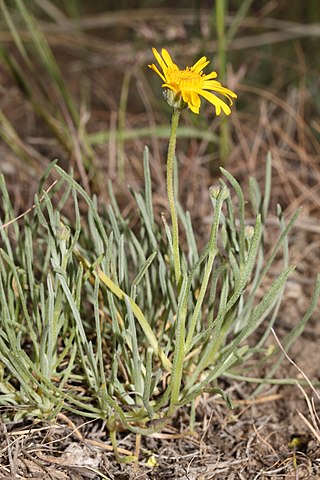
Honeysuckles are arching shrubs or twining vines in the genus Lonicera of the family Caprifoliaceae, native to northern latitudes in North America and Eurasia. Approximately 180 species of honeysuckle have been identified in both continents. Widely known species include Lonicera periclymenum, Lonicera japonica and Lonicera sempervirens. L. japonica is a highly invasive species considered a significant pest in parts of North America, Europe, South America, Australia, and Africa.

Rooibos, or Aspalathus linearis, is a broom-like member of the plant family Fabaceae that grows in South Africa's fynbos biome.

Erigeron is a large genus of plants in the composite family (Asteraceae). It is placed in the tribe Astereae and is closely related to the Old World asters (Aster) and the true daisies (Bellis). The genus has a cosmopolitan distribution, but the highest diversity occurs in North America.

Mirabilis is a genus of plants in the family Nyctaginaceae known as the four-o'clocks or umbrellaworts. The best known species may be Mirabilis jalapa, the plant most commonly called four o'clock.

Ungnadia is a genus of flowering plants in the family Sapindaceae containing one species, Ungnadia speciosa, the Mexican buckeye. It is native to northern Mexico, as well as Texas and southern New Mexico in the United States. The name honours Austrian ambassador Baron David von Ungnad, who brought the horse chestnut to Vienna in 1576, introducing the plant into western Europe.

Saxifraga is the largest genus in the family Saxifragaceae, containing about 465 species of holarctic perennial plants, known as saxifrages or rockfoils. The Latin word saxifraga means literally "stone-breaker", from Latin saxum + frangere. It is usually thought to indicate a medicinal use for treatment of urinary calculi, rather than breaking rocks apart.

The Polemoniaceae are a family of flowering plants consisting of about 25 genera with 270–400 species of annuals and perennials native to the Northern Hemisphere and South America, with the center of diversity in western North America.

Chilopsis is a monotypic genus of flowering plants containing the single species Chilopsis linearis. It is known commonly as desert willow or desert-willow because of its willow-like leaves, but it is not a true willow – being instead a member of the catalpa family.
Trumpetflower or trumpet flower may refer to several plants:

Prunus pensylvanica, also known as bird cherry, fire cherry, pin cherry, and red cherry, is a North American cherry species in the genus Prunus.

Tecoma stans is a species of flowering perennial shrub in the trumpet vine family, Bignoniaceae, that is native to the Americas. Common names include yellow trumpetbush, yellow bells, yellow elder, ginger Thomas. Tecoma stans is the official flower of the United States Virgin Islands and the floral emblem of The Bahamas.

Collomia grandiflora is a western North American annual plant in the phlox family (Polemoniaceae), known by the common names grand collomia, large-flowered mountain trumpet, and large-flowered collomia. It usually appears in sandy habitats and is cultivated as an ornamental.

Collomia linearis is a species of flowering plant in the phlox family known by the common names tiny trumpet and slenderleaf collomia. This tiny wildflower is native to North America, where it is fairly widespread across the north and west. It is an annual herb, rarely exceeding 30 centimetres (12 in) in height, with a velvety erect stem bearing long, narrow green leaves. Atop the stem is a cluster of up to 20 white or light pink flowers, each about a centimeter across. Each has five small rounded petals and stamens tipped with anthers bearing white pollen.

Erigeron linearis is a species of flowering plant in the family Asteraceae known by the common name desert yellow fleabane or narrow leaved fleabane. It is native to western North America.

Melanthera, is a genus of perennial flowering plants in the family Asteraceae, native to North and South America, as well as Africa, Asia and Oceania, including Hawaiʻi.

Persoonia linearis, commonly known as the narrow-leaved geebung, is a shrub native to New South Wales and Victoria in eastern Australia. It reaches 3 m (9.8 ft), or occasionally 5 m (16 ft), in height and has thick, dark grey papery bark. The leaves are, as the species name suggests, more or less linear in shape, and are up to 9 cm (3.5 in) long, and 0.1 to 0.7 cm wide. The small yellow flowers appear in summer, autumn and early winter, followed by small green fleshy fruit known as drupes. Within the genus Persoonia, it is a member of the Lanceolata group of 58 closely related species. P. linearis interbreeds with several other species where they grow together.
Navarretia ojaiensis is a rare species of flowering plant in the phlox family known by the common name Ojai navarretia.
Spenceria ramalana is the lone species in the plant genus Spenceria, known by two varieties. S. ramalana grows from 18–32 cm. tall, and puts out yellow flowers from July through August; bearing fruit from September to October. The Chinese name, ma ti huang [马蹄黄], can be translated to mean "yellow horseshoe".

Saltugilia is a genus of flowering plants in the phlox family, Polemoniaceae. They are known commonly as woodland gilias. There are four species. Two are endemic to California in the United States, and the distributions of the other two extend into Baja California in Mexico.
















